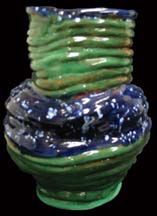
|
A Look into the Play with Clay:
A Ceramics Webquest Ceramics Terminology |
 Webquest Introduction |
 Ceramics Terminology |
 Ceramics Processes |
 Ceramics History |
 Ceramics Forms |
 Task Rubric |

|
A Look into the Play with Clay:
A Ceramics Webquest Ceramics Terminology |
 Webquest Introduction |
 Ceramics Terminology |
 Ceramics Processes |
 Ceramics History |
 Ceramics Forms |
 Task Rubric |
Before any research can be conducted on ceramics, a solid understanding of the field's terminology is needed. This way everyone in the class will be using the same terms, we will all understand what we're taking about, and we will have terms at hand when we need to describe something. As tetious as it may seem to learn terms, it is a necessary thing for communication to occur.
All of the below definitions are found at the online ArtLex Art Dictionary at www.artlex.com.
Clay - Mud; moist, sticky dirt. In ceramics, clay is the basic material, usually referring to any of a certain variety of mixtures of such ingredients -- fine-grained, firm earthy material that is plastic when wet, brittle when dry, and very hard when heated. The most common types of ceramic clays are earthenware, stonewares, and porcelain.
Ceramics or Ceramic Ware - Pottery or hollow clay sculpture fired at high temperatures in a kiln or oven to make them harder and stronger.
Pottery - Objects, and especially vessels -- pots, which are made from fired clay. Pots are functional ceramic objects, and may take such forms as plates, bowls, cups, jars, vases, urns, ewers (pitchers), bottles, and boxes. A pottery can also be a place where pots are made.
Vessel - A hollow container, such as a cup, bowl, or vase, for holding something. Its parts include its foot or base, its walls and opening, its rim or lip, and sometimes: shoulders, neck, lid, handle, etc.
Kiln - An special oven or furnace that can reach very high temperatures and is used to bake, or fire clay. Kilns may be electric, gas, or wood-fired.
Wedging -
Glaze - A term used in ceramics to describe a thin coating of minerals which produces a glassy transparent or colored coating on bisque ware. Typically applied either by brushing, dipping, or spraying, it is fixed by firing the bisque ware in a kiln. This makes the surface smooth, shiny, and waterproof.
Join - To connect, usually permanently.
Scoring - To make scratches or creases in pieces of clay to be joined together. Scoring and applying slip to such roughened surfaces creates a bond that holds the pieces together. If slip acts as an adhesive, and scoring makes two pieces of clay like the opposite sides of a zipper, their combined action -- a zipped zipper with hardened adhesive inside -- should be permanent.
Slip - An opaque, creamy liquid made by mixing finely ground clay with water. It is also used in the making of pottery to cement together parts that have been formed separately; in slip casting, and in decorating surfaces.
Sgraffito (or Graffito) - A method of decorating or designing a surface, as of paint, plaster, slip (engobe), or glaze, by scratching through a layer of one color to expose a different color underneath. Sgraffito is an Italian word literally meaning to scratch. (pr. sgrah-fee'toh)
Greenware - Unfired pottery
Leather Hard - Greenware in which the clay has lost moisture to evaporation, but has not yet completely hardened; clay damp enough to be joined to other pieces with scoring and slip.
Bone Dry - Greenware which is thoroughly room dried and completely hardened.
Bisque - Clay that has been fired once but not glazed.
Even though this is a page dedicated to the sale of their product, it has a great Ceramics 101 Q & A page.
This is a high school page that has a good illustrated ceramics materials page.